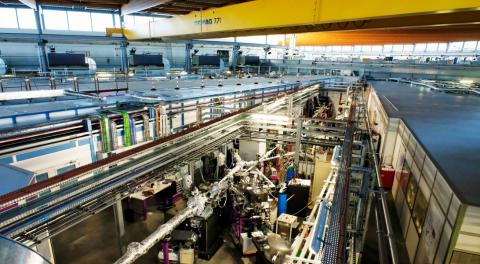Power converters specially designed for CERN can now be used by the wider accelerator community

The Electrical Power Converters (EPC) Group at CERN has developed new software layers to allow the broader particle accelerator community to use the CERN-specific power converters controls.
Power converters are a fundamental part of CERN’s accelerator complex, allowing it to function properly. In particle accelerators, the particle beams are guided by powerful magnets and are accelerated in metallic chambers called radiofrequency cavities. More than five thousand power converters electrically power both these structures. Many different types are needed, ranging in power from a few watts to more than one hundred megawatts. Some produce a steady current or voltage, while others must ramp, or pulse synchronously with all the other equipment in the accelerator. Therefore, the effective operation of each power converter depends on high-performance digital controls that regulate the current in the circuit.
Since the creation of the LHC, CERN power converters use specialised control computers called Function Generator/Controllers (FGCs), integrated into the power converters. An associated FGC software framework was developed to integrate the FGC hardware into CERN’s accelerator controls environment, which is unique to CERN. With the new software stack, the FGC hardware can now be integrated in the TANGO and EPICS control environments, which are the most common control frameworks used at other accelerator infrastructures. This update will open the door for FGCs and CERN-designed power converters to be deployed to other accelerator facilities, such as synchrotrons.
The project to integrate FGCs into the EPICS and TANGO frameworks was conceived in 2014 and resulted in the successful transfer of FGC converter controls to a European manufacturer, who supplied the new power converter to the main cyclotron magnet of the TRIUMF laboratory in 2018. In 2019, CERN provided power converter technology and the associated converter controls to the European Synchrotron Radiation Facility (ESRF). TRIUMF uses EPICS while ESRF uses TANGO.
Thanks to its potential for future technology transfer, the FGC update was one of the five projects selected to receive funding from the KT Fund in 2019. The objective is to continue the FGC framework integration with more commonly used control environments in the context of a collaboration agreement between CERN and SOLEIL.
During the first phase of this collaboration, CERN provided training and lent a standalone FGC and a small power converter controlled by an FGC to SOLEIL. “The SOLEIL upgrade builds on previous experience, gradually moving to a unified controls’ environment for which the FGC framework is particularly suitable,” explains Nick Ziogas, Knowledge Transfer Officer at CERN. In 2020, during phase 2 of the collaboration, eleven controllers of existing commercial power converters installed at the SOLEIL synchrotron (Paris, France) will be replaced by FGCs. SOLEIL intends to procure 1,700 power converters with digital controllers by 2025 for its major upgrade to higher brilliance and these could hopefully be CERN designs using FGC for controls.
At a time when the broader high-energy physics community debates the next-generation of accelerator machines, many laboratories have major upgrades in store for the next decades, aiming to achieve a performance that could lead to more complex science. This means higher luminosity in colliders and higher brilliance in light sources and, therefore, an upgrade of the accelerator infrastructure.
“The FGC framework comes with a powerful software stack that allows for monitoring and diagnosis of faults and the automatic configuration of the controllers following a change of hardware components,” explains Quentin King, head of the Converter Controls Software Section in the EPC Group. “Powerful management tools are vital when large numbers of converter controllers are used. This is a major requirement from all light sources: to have good insight and understanding of what is happening in their power converters.”
The integration of CERN’s FGC framework with the most common accelerator control frameworks, including TANGO, results in an important knowledge transfer opportunity, since it allows the power converters specifically developed for CERN to be used by both partner laboratories and industry, in fields from particle physics to medical and biomedical research.
Article originally published in Accelerating News.
- Log in to post comments
